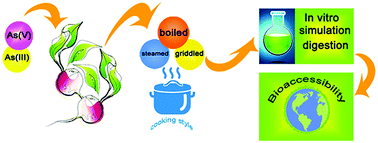Estimation of arsenic bioaccessibility in raw and cooked radish using simulated in vitro digestion†
Abstract
Consumption of arsenic (As)-contaminated vegetables is a major As exposure pathway for humans. However, little is known about plant As uptake characteristics and the bioaccessibility of As after ingestion of As-contaminated radish. The present study investigated As concentrations and species in As-contaminated radish and assessed the effects of steamed, griddled and boiled cooking on the bioaccessibility of As in radish using in vitro digestion. The results showed that the radish accumulated 46.3 ± 2.3, 79.2 ± 1.2 and 113.2 ± 3.7 μg As g−1 when treated with 0.5 mg L−1 As(III) + 0.5 mg L−1 As(V), 1.0 mg L−1 As(III) + 1.0 mg L−1 As(V) and 2.0 mg L−1 As(III) + 2.0 mg L−1 As(V), respectively, in culture solution. In both gastric (G) and gastrointestinal (GI) fractions, the total As and species contents in radish decreased in the following order: raw > steamed > griddled > boiled. The bioaccessibility of total As was 97.5 ± 1.2%, 89.3 ± 1.3%, 84.8 ± 1.2% and 52.1 ± 1.1% in the GI phase when the radish was raw, steamed, griddled and boiled, respectively, and the bioaccessibility was not more than 60.1 ± 2.3% in the G phase. These data suggested that boiled cooking should be recommended for consumption of As-contaminated radish because it reduces total As and its species by approximately 50%. Additionally, organic As forms and factors influencing the bioaccessibility of As should be further studied to scientifically evaluate the health risks of As in radish.



 Please wait while we load your content...
Please wait while we load your content...